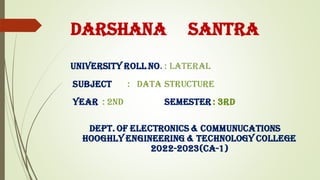
ECE_LARERAL_DATA STRUCTURE_DARSHANA SANTRA.pdf
- 1. DARSHANA SANTRA UNIVERSITY ROLL NO. : LATERAL SUBJECT : data structure YEAR : 2ND 2 SEMESTER : 3RD DEPT. OF ELECTRONICS & COMMUNUCATIONS HOOGHLY ENGINEERING & TECHNOLOGY COLLEGE 2022-2023(CA-1)
- 2. CONTENTS 1. INTRODUCTION 2. Analysis of algorithm 3. Examples 4. Algorithm growth rate 5. Big o notation 6. Big omega notation 7. Big thetanotation 8. What to analyze 9. WHAT IS IMPORTANT
- 3. INTRODUCTION • An algorithm is a set of instructions to be followed to solve a problem. – There can be more than one solution (more than one algorithm) to solve a given problem. – An algorithm can be implemented using different programming languages on different platforms.
- 4. ANALYSIS OF ALGORITHM • Analysis of Algorithms is the area of computer science that provides tools to analyze the efficiency of different methods of solutions. • When we analyze algorithms, we should employ mathematical techniques that analyze algorithms independently of specific implementations, computers, or data. • To analyze algorithms: – First, we start to count the number of significant operations in a particular solution to assess its efficiency. – Then, we will express the efficiency of algorithms using growth functions.
- 5. EXAMPLES } Total Cost = c1 + c2 + (n+1)*c3 + n*c4 + n*(n+1)*c5+n*n*c6+n*n*c7+n*c8 ➔ The time required for this algorithm is proportionalto n2
- 6. ALGOTITM GROWTH RATE • We measure an algorithm’s time requirement as a function of the problem size. – Problem size depends on the application:e.g. number of elements in a list for a sorting algorithm, the number disks for towers of hanoi. • So, for instance, we say that (if the problem size is n) – Algorithm Arequires 5*n2 time units to solve a problem of size n. – Algorithm B requires 7*n time units to solve a problem of size n. • The most important thing to learn is how quickly the algorithm’s time requirement grows as a function of the problem size. – Algorithm Arequires time proportional to n2. – Algorithm B requires time proportional to n. • An algorithm’s proportional time requirement is known as growth rate. • We can compare the efficiency of two algorithms by comparing their growth rates.
- 7. BIG O NOTATION • If Algorithm A requires time proportional to f(n), Algorithm A is said to be order f(n), and it is denoted as O(f(n)). • The function f(n) is called the algorithm’s growth-rate function. • Since the capital O is used in the notation, this notation is called the Big O notation. • If Algorithm A requires time proportional to n2, it is O(n2). • If Algorithm A requires time proportional to n, it is O(n).
- 8. Big omega notation Big-Omega (Ω) notation gives a lower bound for a function f(n) to within a constant factor. We write f(n) = Ω(g(n)), If there are positive constants n0 and c such that, to the right of n0 the f(n) always lies on or above c*g(n). Ω(g(n)) = { f(n) : There exist positive constant c and n0 such that 0 ≤ c g(n) ≤ f(n), for all n ≤ n0}
- 9. Big theta notation Big-Theta(Θ) notation gives bound for a function f(n) to within a constant factor. We write f(n) = Θ(g(n)), If there are positive constants n0 and c1 and c2 such that, to the right of n0 the f(n) always lies between c1*g(n) and c2*g(n) inclusive. Θ(g(n)) = {f(n) : There exist positive constant c1, c2 and n0 such that 0 ≤ c1 g(n) ≤ f(n) ≤ c2 g(n), for all n ≥ n0}
- 10. What to analyze • An algorithm can require different times to solve different problemsof the same size. – Eg. Searching an item in a listof n elements using sequential search. ➔ Cost: 1,2,...,n • Worst-CaseAnalysis –The maximum amount of time that an algorithmrequire to solve a problemof size n. – This gives an upper bound for the time complexity of an algorithm. – Normally, we try to find worst-case behavior of an algorithm. • Best-CaseAnalysis–The minimum amount of time that an algorithmrequire to solve a problemof size n. – The best case behavior of an algorithm is NOT so useful. • Average-CaseAnalysis–The average amount of time that an algorithmrequire to solve a problemof size n. – Sometimes, it is difficult to find the average-case behavior of an algorithm. – We have to look at all possibledata organizations of a given size n, and their distribution probabilities of these organizations. – Worst-case analysis is more commonthan average-case analysis.
- 11. WHAT IS IMPORTANT • An array-based list retrieve operation is O(1), a linked-list- based list retrieve operation is O(n). • But insert and delete operations are much easier on a linked-list- based list implementation. ➔ When selecting the implementation of an Abstract Data Type (ADT), we have to consider how frequently particular ADT operations occur in a given application. • If the problem size is always small, we can probably ignore the algorithm’s efficiency.
- 12. THANK YOU